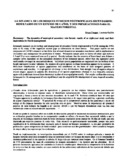| dc.contributor.author | Finegan, Bryan | |
| dc.contributor.author | Guillén, Lucrecia | |
| dc.date.accessioned | 2015-06-08T19:41:17Z | |
| dc.date.available | 2015-06-08T19:41:17Z | |
| dc.date.issued | 1995-12 | |
| dc.identifier.uri | https://repositorio.catie.ac.cr/handle/11554/7045 | |
| dc.description.abstract | Systemic research on the ecology and management of secondary forests implemented at CATIE during the 1980s aims to fill many of the important current gaps in information on these forests. This paper reports on one component of CATIE's research in this field: that of stand dynamics in secondary rain forests, and its application to silviculture and management for production of timber. Permanent sample plots in forests of initial ages between 1.5 and 25 yr were monitored over an 8 yr period. Results indicate that the recovery of forest basal area follows a complex curve dependent on the population dynamics of the dominant species, rather than the sigmoidal curve traditionally envisaged by successional theory. Individual species populations are organised into hierarchies of tree height and access to solar radiation; the position of a given species in these hierarchies appears to be constant. | es_ES |
| dc.language.iso | es | es_ES |
| dc.publisher | CATIE | es_ES |
| dc.relation.ispartof | Semana Científica;2 | es_ES |
| dc.subject | BOSQUE TROPICAL HUMEDO | es_ES |
| dc.subject | BOSQUE SECUNDARIO | es_ES |
| dc.subject | MANEJO FORESTAL | es_ES |
| dc.subject | ECOLOGIA FORESTAL | es_ES |
| dc.title | La dinámica de los bosques húmedos neotropicales secundarios: resultados de un estudio de 8 años, y sus implicaciones para el manejo forestal | es_ES |
| dc.type | Ponencia | es_ES |
| dc.identifier.publisher | CATIE, Turrialba (Costa Rica) | es_ES |
| dc.identifier.publication | Turrialba (Costa Rica) | es_ES |


